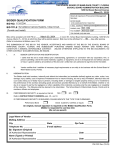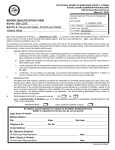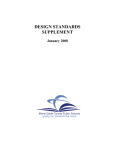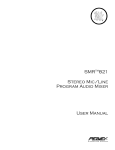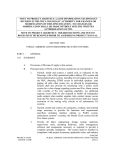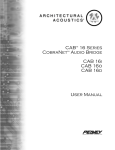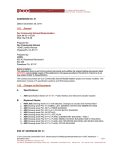Download Care Hawk CH1000 Specifications
Transcript
13745 INTERCOM AND CLOCK SYSTEM ************************************************************************************************************* SPECIFIER: CSI MasterFormat 2004 number: 27 51 16 ************************************************************************************************************* PART 1 GENERAL 1.1 A. SUMMARY Provide a complete microprocessor controlled intercom and clock/bell system as shown on the drawings and as specified herein. 1. System shall include, but not limited to, the following items: a. b. c. d. e. f. g. h. i. j. B. Central system control console including intercom, master clock, Compact Disc (CD) player, RCA inputs and an input for a 1/8th inch stereo mini jack. Clock/speaker units, speakers, administrative telephones, call displays, dual call buttons, uninterruptible power supply, and room program selector switches when required for specific areas. Secondary clocks. Main equipment console. Metal cabinet enclosures for wiring to main equipment rack. Terminal blocks. Testing and certification. Record Drawings. Raceway and pull box systems including conduits and outlet boxes. Speaker/clock back-boxes furnished to the General Contractor by the intercom equipment contractor for installation by the electrical contractor. Intercom system shall be listed by an OSHA approved Nationally Recognized Testing Laboratory (NRTL). C. All equipment shall be installed in accordance with the manufacturer's recommendations. D. Install equipment on the AC voltage supply, taking care to arrest damaging electrical transient and spikes which can cause damage to the microprocessor components of the system. E. Protect all incoming intercom lines by the use of individual circuits surge protectors installed as per manufacturer recommendations. F. Supply, install, adjust, test and guarantee the specified equipment by a factory authorized communications contractor for the products furnished. G. The communication installer supplying the equipment shall show upon request, satisfactory evidence that they maintain a fully equipped service organization capable of performing adequate inspection and services to the system, including replacement parts. Project Name Project No. M-DCPS MASTER SPECIFICATION GUIDELINES Nov. 2014 13745 − 1 H. The installer shall be prepared to offer a service contract for the maintenance of the system after the warranty period. Produce evidence that they have a fully experienced and established service organization for at least five (5) years and proven satisfactory installations during that time. 1.2 A. RELATED SECTIONS: Coordinate the work with the following M-DCPS Master Specifications sections: 1. 2. 3. 4. 5. 6. 7. 8. 9. 10. 1.3 A. REFERENCES: Comply with the latest copies of the following documents: 1. 2. 3. 4. 1.4 07840 - Firestopping and Smoke Sealing. 13740 - Intercom and Clock Raceway Systems. 13770 - Stage Sound System. 13780 - Television Systems. 13805 - Wireless Clock System. 16100 - Basic Materials and Methods 16112 - Raceways and Conduits. 16131 - Outlet, Pull, and Junction Boxes. 16160 - Terminal Cabinets. 16450 - Grounding. Florida Building Code (FBC). National Electric Code (NEC). Federal Communications Commission (FCC) - Part 68. Underwriters Laboratory (UL) or other OSHA approved Nationally Recognized Testing Laboratory (NRTL). SUBMITTALS A. Submit properly identified manufacturer's literature and technical data before starting work. B. Shop drawings shall include, but not be limited to, the following: 1. 2. 3. Three (3) sets. Include the manufacturer’s cut sheets and data sheets for all components. Wiring diagram prepared for the project indicating components and external wiring and connections. Use standard symbols for clocks, speakers, and call-in switches. C. Quality Control Submittals: 1. 2. Submit 5 copies of final test and system certification to A/E for distribution. Provide certification from system manufacturer stating the installer has attended the manufacturer's installation and service school. A certificate of this training shall be provided with the intercom equipment contractor's submittal. D. Closeout Submittals: Project Name Project No. M-DCPS MASTER SPECIFICATION GUIDELINES Nov. 2014 13745 − 2 1. 2. 3. 4. 5. 1.5 Provide 5 operating and maintenance manuals complete with replacement parts data for all systems. Submit 2 copies of the system description and operation. Operating Instructions permanently affixed to all administrative control stations. As built Drawings: Three (3) hard-copy sets and two (2) digital (CD/DVD) sets. They shall include up-to-date drawings that include any changes made to the system during installation. Include circuit diagrams and other information necessary for the proper operation and maintenance of the system. Provide 2 copies of the system programming on CD or DVD to the M-DCPS Project Manager for distribution to M-DCPS Maintenance personnel. QUALITY ASSURANCE A. Systems shall be listed and labeled by an OSHA approved National Recognized Testing Laboratory (NRTL). B. The intercommunications system shall be a standard product produced by a manufacturer of known reputation and experience in the industry. C. The intercom equipment contractor shall provide a letter from the manufacturer certifying the relationship with the manufacturer before bidding. D. Systems being proposed shall provide an FCC registration number with equipment proposal submittal if the system contains a built-in telephone system. Indicate compliance to Part 68 of FCC for any items that may be attached to the Public Switched Telephone Network (PSTN). E. The installer shall be an authorized distributor for the equipment being provided with full manufacturer's warranty privileges. Work includes supervision and termination work. F. The intercom equipment contractor shall maintain at a local facility the necessary spare parts in the proper proportion as recommended by the equipment manufacturer to maintain and service the equipment being supplied. This facility shall be available for inspection by the A/E and M-DCPS at any time. G. Cable Connections: 1. 2. Make actual connection of the wiring to the equipment, either by a certified factory trained technician employed by equipment manufacturer or under equipment manufacturer's direct supervision, without exception. Same factory trained technician shall perform system test and provide certification for same and verify the final Record Drawing. H. The system may have components approved for direct interconnection to the utility services under Part 68 of FCC rules and regulations. 1.6 A. WARRANTY Provide a minimum of 5-year warranty (non-prorated) of the installed system against defects in material and construction, and 2-year warranty on labor. Warranty period shall begin on date of Substantial Completion. Project Name Project No. M-DCPS MASTER SPECIFICATION GUIDELINES Nov. 2014 13745 − 3 B. Provide a 4 hour response time for routine service and trouble conditions and a 48 hour turnaround for repairs or parts replacement. C. A maintenance contract offering extended continuing factory authorized service of this system shall be made available, if requested by M-DCPS. PART 2 PRODUCTS 2.1 PRODUCERS/PRODUCTS A. Model numbers listed in this specification indicate the type of equipment to be furnished. Listed accepted manufacturers shall submit equivalent products as specified in this section. B. Accepted Producers/Products: 1. 2. 3. 4. 2.2 A. Dukane/Care Hawk - Model CH1000. Rauland, Telecenter VI (A Telecenter ICS may be use when it is configured to meet all the requirements of this Master Specifications section). Simplex, 5120 Series Communications Network Controller (for 360 or less station point capacity). Simplex, 5130 Series Controller (for more than 360 point capacity). MANUFACTURED SYSTEM Installation shall include a comprehensive intercommunications system, as specified and as shown on the Drawings, of the modern, dual tone electronic switching type, consisting of the following: 1. 2. 3. 4. 5. 6. 7. 8. A central control incorporating a voice amplified intercom channel. Program tones. Classroom speakers and dual call buttons. Display of calling stations. Uninterruptible power supply. Telephone interface to PBX and hybrid telephone systems. Clocks. Telephones: a. Administrative telephones with pushbutton dialing and either a unit-mounted or desk-mounted display, for the administration of the system. Administrative telephones shall be located as follows: 1) 2) 3) 4) Project Name Project No. One (1) in the Principal’s office. One (1) in the Administration secretarial area, adjacent to the Fire Alarm (FA) panel. One (1) in the Media Center, by the intercom system control console. When the Facility is classified as an Enhanced Hurricane Protection Area (EHPA), provide one (1) administrative telephone within the EHPA Administrator’s office. M-DCPS MASTER SPECIFICATION GUIDELINES Nov. 2014 13745 − 4 B. The central control shall be of the modular plug-in printed circuit board type, using solidstate microprocessor and memory, solid-state sensing and logic. It shall also provide 2wire balanced transmission with dial-tone, ringing, and busy signal capabilities, if applicable. C. The user programmable functions shall be contained in non-volatile memory. D. The system clock automatically restores the proper time of day on all Administrative Control Stations upon restoration of power following an AC power failure. E. The system shall provide at least the following features and functions: 1. 2. 3. Administrative Telephones: Shall be standard Dual-Tone Multi-Frequency (DTMF to AT&T standards) dialing telephones, identical to those supplied by public telephone companies, and each shall have a built-in or a desk-top display. Systems using membrane-type administrative telephones are not allowed. The system shall include a (flush or surface) wall-mounted emergency visual display located directly above the administrative telephone located in the Administration secretarial area. All digital readout displays (in telephones or on the wall), shall perform the following: a. b. c. d. Display all incoming calls by their designated room number, and in the order received. Display shall show the room number for the entire length of the call. Show visually in the order received, 3 calls at one time, and also "store" additional calls. Immediately display the calling station room number of all priority (emergency) calls in an identifiable manner. 4. Capability for expanding the system to accommodate 200 call-in or speaker locations for elementary schools and 500 call-in or speaker locations for middle and high schools. Systems not accommodating these quantities of speakers/call-in switches are not allowed. 5. Direct-dialing, 2-way intercom between locations equipped with administrative telephone and staff/ classroom station speakers, without the use of a press-to-talk or talk-listen switch. 6. Minimum of two separate intercom channels to allow simultaneous communication between any two administrative telephones and any two locations. 7. Provisions for user-programmable "executive override", allowing assigned administrative telephones (to be programmed by a designated administrative telephone), to "break-in" on ongoing conversations in the system. 8. Facilities for the instantaneous distribution of emergency announcements simultaneously to locations equipped with speakers, by dialing a predetermined code number. 9. Provisions for restricting emergency announcements and alarm signal origination to certain assigned administrative telephones. This assignment shall be user programmed by a designated administrative telephone. 10. Provisions for zone-page and all-page restriction. This assignment shall be userprogrammed by a designated administrative telephone. 11. Capability for assigning speaker locations within any one or more of 8 zones for zone paging or time signal reception. This assignment will be user-programmed by a designated administrative telephone. Systems without this feature are not allowed. Project Name Project No. M-DCPS MASTER SPECIFICATION GUIDELINES Nov. 2014 13745 − 5 12. Provision for calls originating from any staff/ classroom station location shall be userprogrammed by a designated administrative telephone for assignment to any location having displays. Systems unable to so direct station calls are not allowed. Classroom stations shall be provided with dual call-in switches. Locate wall display next to the fire alarm and the main display phone. 13. Facilities for answering calls registered in the readout display by dialing their number. Provide facilities for activating graphic display panels (lighted annunciators). 14. Provide provisions to cancel all staff/classroom station-originated calls from any authorized administrative telephone. 15. The system shall be capable of restricting and authorizing functions by software programming from the designated programming administrative telephone. This programming shall be capable of allowing the individual ports to work with any of the following combinations of station equipment: a. b. c. d. Administrative telephone (with dial). Administrative telephone with speaker circuit. Speaker with call-in switch. Speaker only. 16. Emergency Calls: An emergency call to the office from any "call-in" station shall have a priority alert over other existing communications in the console at the time of the emergency call by means of a high-pitch continuous buzzer/ring until call is acknowledged. In addition, if the emergency call is not answered within 60 seconds, the emergency calls shall be annunciated over designated intercom speakers and announcement shall include the room number making the emergency call. 17. It shall be possible to make software-feature assignments from the designated programming administrative telephone as follows: a. b. c. d. e. f. Assignment of each speaker to any combination of 8 paging zones for time-tone zones. Assignment of loudspeaker intercom access to a group of 1 or more administrative telephones. Assignment of "executive override" to authorized administrative instruments. Hotline ringing of a programmed telephone station automatically to a designated location without digital readout capability. Allow/disallow paging, emergency tones, zone page, outside (trunks) line access. Assignment of numbering system (4 numeric characters (0-9) plus one alpha character (a-j), and selected one-digit access codes. 18. The central console shall contain a serial data port or Ethernet port for connection of on-site or off-site diagnostics by a distributor or other factory authorized personnel. It shall be possible to determine circuit and software faults via these diagnostics and facilities and to make remote software changes and updates to the system. The system shall also maintain statistics of operations of the main system functions for use by the individual administering the system. 19. The system shall be capable of operating with loop start trunks. In addition, it may use ground start or 4 wire audio and 2 wire signal (E&M) for compatibility with existing and future utility services. It shall be capable of interfacing with the telephone systems installed in schools. 20. The system shall be compatible with standard PBX signaling for connection to any existing or future PBX if it contains a built-in telephone system. Project Name Project No. M-DCPS MASTER SPECIFICATION GUIDELINES Nov. 2014 13745 − 6 21. Provide the following spare parts: a. b. c. F. One spare “circuit board” or “switching card” (depending on manufacturer), of each type used. One power supply assembly unit. One spare surge suppression. Components: 1. If the installation includes a 2-channel program distribution system, it shall consist of the following components: a. b. 2. Master Control Panels: a. 3. The intercom system shall have a minimum of 5 program inputs (2 microphone and 3 auxiliary), each selected by a programmable dialed code with full aural and visual monitoring device by means of a built-in monitor speaker and LED output level indicators, and separate "All-Call" and "Emergency" announcement facilities. Program Preamplifier: a. b. c. d. e. 4. Two (2) program power amplifiers. CD player with a mini 1/8-inch stereo input jack and RCA inputs. The program preamplifier shall have an output rating of 1.5 volts into 10,000 ohms at less than 1 percent distortion from 40 to 15,000 Hertz. Frequency response shall be flat within +2 dB over this range. Microphone inputs shall be balanced 150 ohms. Auxiliary inputs shall be 500K ohms unbalanced with a 0.25 volt sensitivity. Provide a tone control. CD Player: a. CD player shall be rack mountable on the intercom equipment rack and shall have the following key features: 1) 2) 3) 4) 5) 6) 7) 8) 9) 10) 11) 5. CD –R/RW Playback Compatibility. +/- 12% Pitch Control. Instant Start. Direct Track Select Buttons. User Preset Functions. MP3 Playback Compatibility. Repeat Mode (Single Track/All Tracks/Program and Random Repeat). Coaxial RCA Digital Output (SPDIF). Frequency Response: 20 Hz – 20kHz. Total Harmonic Distortion: 0.007%. Power Supply: AC120V, 60 Hz. Power Amplifiers: Project Name Project No. M-DCPS MASTER SPECIFICATION GUIDELINES Nov. 2014 13745 − 7 a. b. c. d. e. f. g. Design the power amplifiers, if used, for completely dependable continuous operation in alarm, paging, and sound reinforcement use. They shall meet the UL 1480 standard requirements for amplifiers intended for use in fire-protective signaling systems. The amplifiers shall deliver an output as designed for the system at elementary, middle, and high schools at less than 2 percent harmonic distortion at full rated output. Manual or Automatic reset DC circuit breakers shall be provided as needed to safeguard against damage from prolonged overloads and from extreme overloads, such as a shorted output line. Input power protection shall be provided by an easily replaceable slow-blow fuse. Controls shall be provided for level control and lo-cut filter to protect horn-type speakers. A LED protection indicator shall be provided. The amplifier shall operate continuously from 120 VAC. The 120 VAC shall be supplied from a panel fed from the emergency generator if there is a power failure. ************************************************************************************************************* NOTE TO SPECIFIER: Not all of the manufacturer's systems listed include switch panels, since intercoms can be installed with or without switch panels. Edit the following paragraph to suit project conditions. ************************************************************************************************************* 6. For the program distribution system, provide the following functions: a. b. c. d. e. Transmit one program from one source to one or a group of loudspeakers. Select from five (5) program sources for one program channel. Distribute a program to all speakers by means of an all-call switch. Provide a Switchcraft B3F microphone jack on the front of the equipment rack wired to microphone 1 input. Aurally and visually monitor a program before and during distribution to speakers. ********************************************************************************************************************* NOTE TO SPECIFIER: The following Tone Generator and Master Clock System are integral to the intercom system. See Section 13805 for an optional wireless clock system not requiring a separate clock conduit. Consult with MDCPS Staff from Facilities Design and Standards to determine if the use of a wireless clock system is acceptable for the Project. ********************************************************************************************************************** G. Tone Generator: 1. 2. The installation shall include a tone generator or WAV file system for distributing class change and emergency signaling tones to loudspeakers. The tone generator or WAV files shall be capable of producing at least 7 different and distinct tone signals. The tones shall be activated in the following 3 ways: a. Tones shall be activated by dialing access codes from authorized administrative phones via the communications system central control. b. Tones shall be activated via signals from the master program clock. H. Master Clock System: Project Name Project No. M-DCPS MASTER SPECIFICATION GUIDELINES Nov. 2014 13745 − 8 1. Micro-processor base programmable by the user through electronic means. a. b. 2. The programmable master control clock shall be capable of storing and controlling a minimum of 350 events in non-volatile memory. It shall program and control the following: a. b. c. 3. The time the event is to occur and whether AM or PM. The selection of any zone or any combination of zones (minimum of 8) where the event is to occur. A minimum of 6 schedules to allow flexible rearrangement of events to accommodate special circumstances. The master control clock shall provide for the electronic selection of the following operational "modes": a. b. c. d. e. f. 4. Provide a step-by-step guide to enable the user to accomplish the programming easily and correctly. Master control clocks which are not micro-processor based or that require a technician to perform the original programming and subsequent program changes at additional cost to M-DCPS, are not allowed. "TIME": Allow the entry of "present" time display on the clock panel. "DATE": Allow the entry of the current date. "LOAD": Access entry of each element into the clock memory. "EDIT": Allow the sequential display of programs entered, for the purpose of review, correction, change, or deletion. "SELECT": Allow the activation of zones and schedules. "RUN": The mode for normal operation. The master control clock shall provide pushbuttons for accomplishing the programming and shall require no special skill or training to perform. a. By following a simple set of step-by-step instructions, operation of these buttons shall insert into the clock memory the following elements required for programming an event: 1) 2) 3) 4) 5) b. 5. The time it is to occur. AM or PM. The zone or zones it is to occur. The day or days each zone is to be active. The selection of up to 4 schedules required to accommodate normal or special circumstances. Once the programming for an event has been completed, the entire program shall be clearly displayed for review before it is entered in the memory. The Master Control Clock shall provide: a. b. c. Project Name Project No. Digital display. Pushbuttons for manually controlling each zone. A pushbutton for manually activating all zones simultaneously. M-DCPS MASTER SPECIFICATION GUIDELINES Nov. 2014 13745 − 9 d. e. Pushbuttons for selecting schedules. Synchronize to the US Naval Observatory (USNO) time, a minimum of once every 24 hours, using a GPS receiver. f. Interface with secondary clocks, either analog or digital, with provision for hourly and 12-hour corrections. g. Ability to program for automatic holiday operation. h. Ability to program for required secondary clock correction. i. Software selection of user zones (4, 6, or 8) or schedules. j. Ability to program a combination of zones or schedules for each day. k. Automatic daylight-saving time change, easily accomplished by user programming. l. Display of the next scheduled event on the clock by pushing a single button. m. A key lock to prevent tampering with the clock or making unauthorized program changes. n. Programmable signal duration from 1 to 59 seconds. o. User programming of different duration for each zone. p. A "zero" duration programmable for latched operation. q. Selection of 12-hour or 24-hour display format. r. A battery backup kit. s. Instruction panel for rack mount, detailing programming procedure in step-bystep sequence. t. AC or DC output buffer modules. 6. 7. 8. The power requirements for the programmable master clock shall be 120 volts AC, 60 Hz. It shall be available for standard rack or for wall mount. The clock shall incorporate all-solid-state circuitry, and shall meet requirements of ANSI/UL 60065. The master control clock shall be capable of driving both analog and digital secondary clock simultaneously through solid-state-relay type buffer modules. Secondary Clocks: a. b. c. d. Flush mounted. Shall be 24-volt DC impulse or 24-volt AC synchronous. Shall be regulated by the master control clock each hour for “minute” correction, and every 12 hours for “hour” correction. “Reduced Wire System” - Clocks having the ability of using an associated intercom/paging system’s speaker wires for power and correction are acceptable. ************************************************************************************************************* NOTE TO SPECIFIER: Edit the following item to suit project specific design requirements. Note that digital secondary clocks may be used only with prior written permission from M-DCPS Facilities Design and Standards on a per condition basis. ************************************************************************************************************* e. Secondary clocks shall be [analog][digital]. 1) [Analog Clocks:] a) b) c) d) e) Project Name Project No. Size: Nominal 12" diameter. Clock motion: Mechanical. Display: Standard 12-hour dial-face with black numerals. Clock dial face shall be white and impervious to discoloration. The hour and minute hands shall be black. M-DCPS MASTER SPECIFICATION GUIDELINES Nov. 2014 13745 − 10 f) 2) [Digital Clocks:] a) I. Provide a 4-digits (hours and minutes) 12-hour display, with red color 4" inch high LED digits. Equipment Racks: 1. 2. 3. 4. 5. 6. 7. 8. 9. 2.3 The clock case shall be metal or ABS, with a black or silver finish. Clock shall be supplied with a sway-proof hinge for secure mounting. Mount control components of the communications system, the program distribution system, the tone generation system, and the master program clock system in free standing upright metal equipment rack(s) designed to mount standard 19 inch components. Properly size the racks to accommodate necessary equipment panels with 20 percent spare blank panel space. At least 61.25 inches of total vertical panel space shall be provided. Controls shall be handicapped accessible according to Americans with Disabilities Act (ADA). Construct the rack of at least 16 gage steel, heavily reinforced for maximum strength and durability equipped with casters. Provide a hinged and key-locking rear door providing authorized personnel with easy access to the equipment. The rack shall be finished in ebony black baked enamel, and shall be listed by Underwriters Laboratories (UL) or other NRTL. Included in the rack shall be a roll-out storage drawer 8.75 inches high by 14.25 inches deep, with a face panel styled to match the other equipment panels in the rack. The roll-out mechanism shall be of the dual-section type providing at least 12.25 inches total extension. Include in the rack a shelf 12 inches deep across the front of the rack. EQUIPMENT A. Intercommunications System: As supplied by the intercom equipment contractor. B. Master Control Clock System: As supplied by the intercom equipment contractor. C. Tone Generator System: As supplied by the intercom equipment contractor. D. Rack and Associated Hardware: 1. 2. 3. E. Microphone input jack, exterior speaker ON/OFF switch, and tone signaling pushbuttons (1 required). Fill unused panel spaces with blank panels. Label inputs, switches, and controls with permanent markings. Indicate rooms and areas served. Speakers: 1. Remote speakers shall be 8 ohms, with a 25-volt transformer with a minimum of five (5) taps ranging from 0.5 watt to 5 watts. Project Name Project No. M-DCPS MASTER SPECIFICATION GUIDELINES Nov. 2014 13745 − 11 a. b. Room Speakers: Mounted in clock/speaker combination baffles. Interior Ceiling Speakers: 1) 2) c. 2. 3. F. Exterior Speakers: In weatherproof housing. Speakers shall be tapped according to room requirements. Provide keyed operated speaker controls (On/Off) at: a. b. c. 4. Mounted in baffle with back-box and T-bar Support. Adequately support speakers in acoustical ceilings by hanger wires to eliminate panel deflection. CCTV Control room and CCTV Studio. Cafetorium/Auditorium Stage area. Other locations as may be called for on the Contract Documents. Provide a speaker (high-low) volume control switch at the Principal’s and at each Assistant Principal’s Office. Locate volume switch adjacent to the Staff’s technology center at 48" AFF. Call-in Switches: 1. Classroom call-in switches shall be Rauland TCDPB2 or A/E accepted equivalent. G. Raceways: 1. Raceways shall be in accordance with M-DCPS Section 13740 – Intercom and Clock Raceway System. H. Clock/Speaker Enclosures: As supplied by the intercom equipment contractor. I. Wire: 1. 2. 3. 4. Wiring shall be according to good engineering practices as established by the EIA and NEC. Wiring shall meet established state and local electrical codes. Wiring shall test free from grounds and shorts. Install wiring according to the following: a. Cable Requirements: 1) b. c. d. e. f. Project Name Project No. Administrative Telephones, Speakers, Call-in Switches, Emergency Call Answer Panel: West Penn #373 for aboveground use and West Penn AQC#369 for underground use or accepted equivalent. Cat5 cable or better is acceptable for systems having the capability to utilize this type cable. Speaker wire shall be a shielded cable. Conductors shall be color-coded. Microphone wire shall be a 2-conductor shielded cable, No.18 AWG, with PVC jacket, for microphone use, West Penn Cable No.293 or equal. Digital Wall Display: As determined by system supplier. Secondary Clocks: As called for in this Master Specification Section. Wiring: M-DCPS MASTER SPECIFICATION GUIDELINES Nov. 2014 13745 − 12 1) 2) g. h. i. 5. 6. 7. Three No.12 AWG THHN or Use associated intercom/paging system’s speaker wires for power and time correction. Provide all intercom and clock wiring in raceways. Mount a momentary pushbutton remote from the speaker baffle for signaling the central console in each room. Install suitable type hinged terminal cabinets as indicated on plans. Provide marked terminal strips in all junction boxes. Soldered and tap joints will not be permitted. Provide isolating barrier in clock/speaker enclosure so as to keep wiring separated. Whenever possible, install homerun wiring in continuous runs from field device to head-end terminal cabinet with no breaks or splices. Splices in wire trays are not allowed. Clock splices/ taps shall be on screw terminals or terminal strips in an accessible junction box. Wire terminations for the intercom and clocks at the central equipment rack shall be made on terminal blocks, Suttle SE66M1-50 with SE-89D brackets, or accepted equivalent. The terminal blocks shall be installed in a flush mounted terminal cabinet where possible, Brenner-Newman Model BN7036 or accepted equivalent. Systems utilizing fiber optic cabling between remote terminal cabinets and head-end terminal cabinet are acceptable. PART 3 EXECUTION 3.1 A. 3.2 A. EXAMINATION Do not proceed with the work of this section until conditions detrimental to the proper and timely completion of the work have been corrected in an accepted manner. PREPARATION Provide necessary transient protection on the AC power feed, station lines leaving or entering a building, and central office trunks. Protection shall be as recommended by the equipment supplier and referenced to earth ground. 1. B. Lightning protection and transient voltage and surge suppression shall be provided as recommended by system manufacturer. The system shall be powered by a separately fused, 110 volt AC circuit fused with a circuit breaker of 20 Amps. The circuit shall be on an electrical panel connected to the emergency generator in case of a power failure. C. Speaker wires and call-in circuits shall be protected by an individual circuits surge suppressor or accepted equivalent at the central rack termination equipment cabinet. Gang strips surge suppressors are not allowed. D. Note in system drawings the type, locations, and wiring information of protection devices. E. Wiring termination shall be accomplished on standard telephone-type punch down blocks. Project Name Project No. M-DCPS MASTER SPECIFICATION GUIDELINES Nov. 2014 13745 − 13 F. 3.3 Provide a rack mounted battery backup system or accepted equivalent with a capacity for operating the head-end under normal idle load for 2 hours and then operating the system in at full power to all speakers for 5 minutes after the end of the idle period. INSTALLATION A. Provide and Install the intercom and clock systems according to applicable codes and the Contract Documents. B. System equipment and wiring installation shall be by the properly licensed company, either the original equipment manufacturer or the factory distributer for the brand of equipment used. Furnish wiring diagrams and wire runs for the raceway system installed by the licensed electrical contractor, under Division 13 and 16. C. The system shall be tested for shorts, grounds, continuity, and finally for proper functioning and operation. D. Final connections of equipment, testing of system, and any other necessary adjustments shall be performed by a certified factory trained technician, employed by the equipment manufacturer, and under the manufacturer's direct supervision. E. Equipment shall be installed according to manufacturer's recommendations. F. Installation of head-end or control equipment shall be done only by the employees of the factory authorized distributor of the equipment being installed. G. Install wiring, conduit, boxes and the like required for installation of a complete system as specified in this section and as shown on the drawings according to manufacturer's instructions, accepted submittals, and the requirements of this section. 1. 2. 3. 4. Color code wires. Tag wires at junction points. Wire terminations shall be made at equipment terminals or at terminal cabinets. No splices are allowed in the systems. Install wiring in conduit free from opens, grounds, or crosses between conductors. Do not use PVC or other plastic conduit above ground. H. Number of wires shall be according to manufacturer's wiring diagram. Install wiring in conduit. Pull and junction boxes and terminal cabinets for the system shall be provided with terminal strips, identified for wire terminations, and painted yellow. I. Terminations shall be in hinged terminal cabinets and provided with wire tabs. Solder or taped joints are not allowed. Loop through wiring is allowed, but spares shall be terminated. J. Furnish and install entire system according to accepted shop drawings of equipment and wiring diagrams. 3.4 A. FIELD QUALITY CONTROL Factory trained technician shall check and test system for shorts, grounds, and circuit continuity and finally for proper function and operation before scheduling initial system test by M-DCPS. Project Name Project No. M-DCPS MASTER SPECIFICATION GUIDELINES Nov. 2014 13745 − 14 B. 3.5 After M-DCPS initial testing approval, a continuous 30 calendar day period of trouble-free operation is required before system acceptance. DEMONSTRATION A. After system has been tested, checked, and certified as complete and operational, technician shall demonstrate various functions and operations of system to A/E and MDCPS maintenance and administrative staff. B. Demonstrate and explain system functions and operations in detail to school personnel designated by the school’s principal. C. Furnish a minimum of 8 hours or as needed to provide adequate in-service training with this system. These sessions will be broken into segments to facilitate the training of individuals in operating station equipment, administrative devices, user programming functions, and program distribution equipment. Operating manuals and user's guides shall be provided at training sessions. D. Provide all school staff participating in the in-service training with hand-out material providing basic knowledge of system operation. E. 3.6 A. Training for software updates to the program (via serial port or Ethernet) by an "allowed" programming instrument, shall be given to personnel designated by M-DCPS in making these updates to the restriction tables. EXISTING BUILDINGS Existing intercom and clock systems replaced with a new intercom and clock system installation shall have existing panels, sub-panels, power supplies, speaker/clock assemblies, and any other non-operational component removed after the new intercom and clock system certificate of completion is accepted by M-DCPS. END OF SECTION Project Name Project No. M-DCPS MASTER SPECIFICATION GUIDELINES Nov. 2014 13745 − 15















